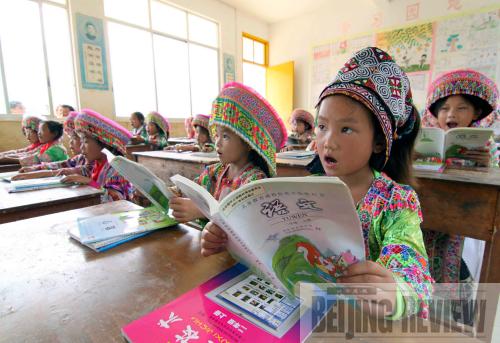-l Improving population structure
China's population structure underwent a historic change after the founding of New China, transitioning from a country with a high birth rate, high death rate and low growth rate to one with a high birth rate, low death rate, and high growth rate. Currently, the Chinese population has reached a controlled balance, with a low birth rate, low death rate and low growth rate. From 1952 to 2008, it rose from 570 million to 1.328 billion, with the birth rate dropping from 37.00 per thousand to 12.14 per thousand, the death rate falling from 17.00 per thousand to 7.06 per thousand and the natural population growth rate falling from 20 per thousand to 5.08 per thousand.
China adopted a family-planning policy in the early 1970s, and executed a policy permitting urban parents, except ethnic minorities, to have only one child in the early 1980s. The rapid decrease in the birth rate triggered major changes in the population structure, relieving the social pressure that a larger population would have created.
As a result, the people's quality of living has been able to increase. The number of college graduates and skilled workers, as well as the overall quality of the labor force, has been on the rise.
- Eliminating poverty
The number of poverty-stricken people in China's rural areas decreased to 14.87 million in 2007 from 250 million in 1978. A World Bank report released in 2007 said China accounted for 67 percent of the achievements in global poverty reduction in the past two decades. Without China's efforts, the poor population in the world would have continued to grow, it said. China is also the only country that has halved its poor population ahead of schedule, according to the UN Millennium Development Goals.
Poverty relief has entered a new stage since the beginning of the 21st century. The Central Government adopted the Outline for Poverty Alleviation and Development in China's Rural Areas (2001-2010), focusing on eliminating poverty in 592 key poverty-stricken counties by 2010. Meanwhile, it will also commit resources to narrow the gap between urban and rural areas to achieve a balanced growth throughout the country.
- Building a social safety net
China developed a relatively comprehensive social security system, providing a basic foundation for its industrialization and urbanization after the founding of New China. However, the social security system formed under the planned economy had many flaws, covering only a small fraction of the population with weak protection. The living allowance remained unchanged for years.
Beginning in 1984, the government made several initial attempts to reform the flawed social security system. It expanded the coverage of the social security network, raised the living allowance, increased insurance coverage, balanced the burden on different employers, and adopted rules and regulations guiding social security programs. Since then, the social security system has been legalized, standardized, and socialized. Under the planned economy, the government and danwei—state-owned institutions where people worked—were responsible for providing social security. But in the current market economy, employees, the institutions they work for, and the government jointly contribute to the social security network.
 |
|
HOPE FOR THE FUTURE: Children from poverty-stricken families in Yaowo Village in Guangxi Zhuang Autonomous Region read from books they received for free through government assistance programs (LIN BIN)
|
In 1993, China officially announced its intentions to establish a socialist market economy. That same year, it also clarified the main content of its social security system and set into motion plans to develop multi-level pension and medical insurance systems by combining social pooling with individual accounts. The social security system reform eventually spread throughout the country, with a focus on introducing pension, medical and unemployment insurances, in a bid to set up a social security system adaptable to the development of the socialist market economy.
In 1994, the Third Plenary Session of the 14th CPC Central Committee passed a resolution to establish a socialist market economy, in which it put forward a systematic plan for China's social security system reform. The document suggested a gradual transition to the system of combining social pooling and individual accounts so as to adapt to China's economic restructuring.